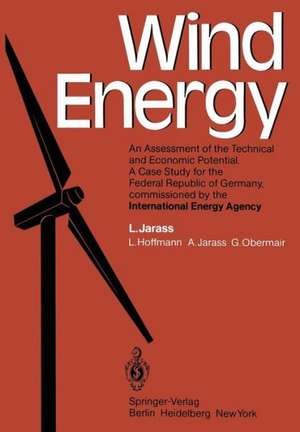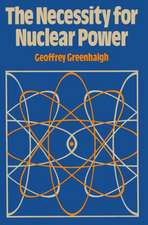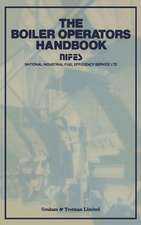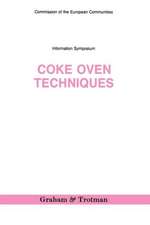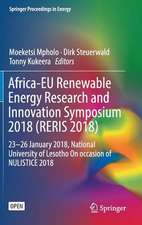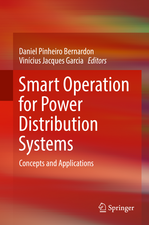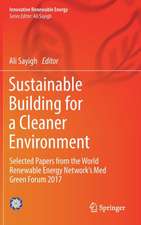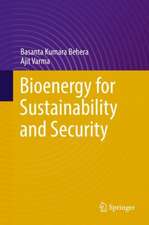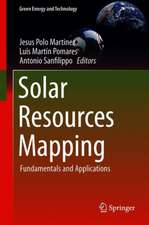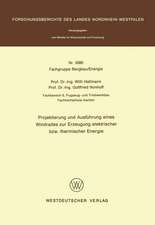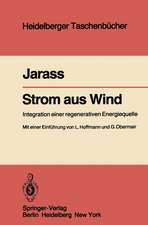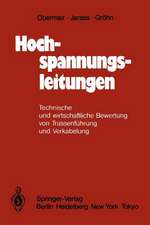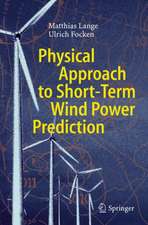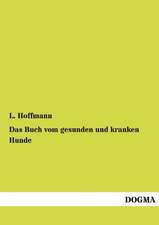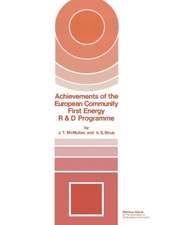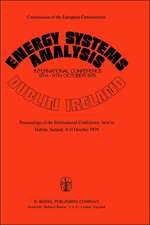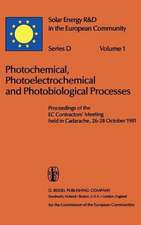Wind Energy: An Assessment of the Technical and Economic Potential A Case Study for the Federal Republic of Germany, commissioned by the International Energy Agency
Autor L. Jarass, L. Hoffmann, A. Jarass, G. Obermairen Limba Engleză Paperback – 4 mai 2012
Preț: 386.22 lei
Nou
Puncte Express: 579
Preț estimativ în valută:
73.90€ • 77.16$ • 61.16£
73.90€ • 77.16$ • 61.16£
Carte tipărită la comandă
Livrare economică 04-18 aprilie
Preluare comenzi: 021 569.72.76
Specificații
ISBN-13: 9783642887093
ISBN-10: 3642887090
Pagini: 228
Ilustrații: XI, 212 p. 86 illus.
Dimensiuni: 170 x 244 x 12 mm
Greutate: 0.37 kg
Ediția:Softcover reprint of the original 1st ed. 1981
Editura: Springer Berlin, Heidelberg
Colecția Springer
Locul publicării:Berlin, Heidelberg, Germany
ISBN-10: 3642887090
Pagini: 228
Ilustrații: XI, 212 p. 86 illus.
Dimensiuni: 170 x 244 x 12 mm
Greutate: 0.37 kg
Ediția:Softcover reprint of the original 1st ed. 1981
Editura: Springer Berlin, Heidelberg
Colecția Springer
Locul publicării:Berlin, Heidelberg, Germany
Public țintă
ResearchCuprins
1 The Possible Position of Wind Power within the Future Energy Supply of the Federal Republic of Germany.- 1.1 Long-Term Development of Energy Demand.- 1.1.1 Total Energy Demand.- 1.1.2 Demand for Electricity.- 1.2 Long-Term Development of Energy Supply.- 1.2.1 Total Energy Supply.- 1.2.2 Supply of Electricity.- 1.3 Development of Electricity Costs.- 1.4 Wind Energy Potential and its Possible Utilization.- 2 Determinants of Wind Power Utilization.- 2.1 Meteorological Conditions.- 2.1.1 Wind as a Meteorological Phenomenon.- 2.1.2 Wind Potential.- 2.2 Criteria Governing the Choice of a Suitable Location for Wind Power Stations.- 2.3 Fundamental Questions of Wind Technology: Technical Installations, Integration into the Grid System.- 2.3.1 Technical Installations.- 2.3.2 Integration into the Existing Grid.- 2.4 The Economic Efficiency of Wind Power.- 2.4.1 Evaluation from the Private Point of View.- 2.4.2 Evaluation from the Social Point of View.- 2.4.3 Mode of Calculation.- 3 Research Goals of the Study.- 3.1 The Questions to be Discussed.- 3.2 Program of the Investigations.- 4 Wind Conditions in the Federal Republic of Germany.- 4.1 Wind Data.- 4.1.1 Data Material.- 4.1.2 Representativeness of Data Material.- 4.1.2.1 Height of Measurement.- 4.1.2.2 Temporal Resolution and Observation Period.- 4.1.2.3 Methods of Measurement.- 4.1.2.4 Applicability to Other Locations.- 4.1.2.5 Summary of the Representativeness.- 4.2 Evaluation of the Wind Data.- 4.2.1 Magnitude and Structure of Wind Speed.- 4.2.1.1 Considerations in Respect of Mean Values.- 4.2.1.2 Potential of Wind Power.- 4.2.1.3 Temporal Distribution of Wind Speed.- 4.2.2 Regularity of Wind Speed.- 4.2.2.1 Standard Deviation of Wind Speed.- 4.2.2.2 Detailed Structure of Lulls.- 4.2.2.3 Extreme Wind Velocities.- 4.2.3 Daily and Seasonal Variation of Wind Velocity.- 4.2.3.1 Daily Time-Evolution of Wind Velocity.- 4.2.3.2 Annual Time-Evolution of Wind Velocity.- 4.2.4 Correlation of Wind Speeds.- 4.2.4.1 Autocorrelation of Wind Speeds.- 4.2.4.2 Correlation of Wind Speeds Between Separate Observation Points.- 4.2.5 Wind Direction Investigations.- 4.2.6 Summary: Wind Situation in the Federal Republic of Germany.- 4.2.6.1 Mean Values.- 4.2.6.2 Daily and Seasonal Time Variation of Wind Speed and Energy Demand.- 4.2.6.3 Temporal Distribution of Wind Speed.- 4.2.6.4 Lulls.- 4.2.6.5 Correlation of Wind Speeds of Stations Lying at Some Distance from One Another.- 4.2.6.6 Extreme Wind Velocities.- 4.2.6.7 Wind Directions.- 4.2.6.8 Locations Favorable for Wind Power Generation.- 5 Conversion of Kinetic Energy (Wind Power) into Electrical Energy.- 5.1 Physical-Technical Basis.- 5.2 GROWIAN Technology: Reference Wind Power Plant.- 5.3 Wind Power Production.- 5.3.1 Quantities Bearing Central Influence upon the Energy Production of Wind Power Plants.- 5.3.2 GROWIAN’s Wind Power Production.- 5.4 The Use of Storage Facilities to Regularize Wind Power Production.- 5.5 Capacity Displacement Capability and Fuel Saving Effect of Wind Power Plants.- 5.6 Potential of Wind Energy.- 6 The Conventional Energy Supply System.- 6.1 Demand.- 6.2 Production Capacities.- 7. Swing: A Simulation Model for the Integration of Wind Power into the National Grid.- 7.1 Description of the Model.- 7.1.1 Objective.- 7.1.2 Input Quantities.- 7.1.2.1 Demand.- 7.1.2.2 Power Plant.- 7.1.2.3 Wind Power Plants.- 7.1.3 Simulation of Power Plant Standstills.- 7.1.3.1 Planned Standstills.- 7.1.3.2 Unplanned Standstills (Outages).- 7.1.4 Strategy of Employment of Power Plants.- 7.1.5 Integration of Wind Power.- 7.2 Graphical Representation of a Typical Simulation Run.- 7.3 Results of Model Runs.- 7.3.1 Basis of Model Runs.- 7.3.1.1 Reference Values of the Basic Parameters.- 7.3.1.2 Characteristic Values Which are Important for the Results.- 7.3.2 Alteration of Some Central Given Values of the System.- 7.3.3 Varyingly High Demand Figures, and Varyingly High Penetration Rates of Wind Power Plants.- 7.3.4 Integration of GROWIAN Wind Power Plants.- 7.3.5 Alteration of Several Central Parameter Values.- 7.3.6 Development of the Results Over Several Years.- 8 Fuel Saving through the Use of Wind Power Plants.- 8.1 Amount of Fuel Saved by Wind Power Plants.- 8.1.1 Amount of Wind Power Production.- 8.1.2 Additional Power Control.- 8.1.3 Non-Usable Wind Power.- 8.1.4 Fuel Saving with Growing Installed Wind Capacity Under Consideration of Standstills, Control Losses and Non-Usable Wind Energy.- 8.2 Nature of Fuel Saved.- 9 Displacement of Power Plant Capacity by Wind Power Plants (Capacity Credit).- 9.1 Assured Load Carrying Capability of Conventional Power Plants.- 9.1.1 Basis of the Procedure.- 9.1.2 Determining the Increment of the Assured Load Carrying Capability.- 9.1.3 Relation Between Installed Capacity and Standard Deviation of the Available Capacity of a Power Plant System.- 9.2 Increase in Assured Load Carrying Capability by Wind Power Plants.- 9.2.1 Basis of the Procedure.- 9.2.2 Determining the Increase in Assured Load Carrying Capability.- 9.3 Determining the Conventional Power Plant Capacity Displaced by Wind Power Plants (Capacity Credit).- 9.4 Raising the Capacity Displacement Capability of Wind Power Plants by Means of Storage Plants.- 10 Summary I: Fuel Saving and Displacement of Conventional Power Plant Capacity.- 10.1 Basis and Assumptions.- 10.2 Central Results.- 10.3 Variations in Fuel Saving and Displaced Conventional Power Plant Capacity from Year to Year.- 10.4 Influence of Annual Mean Wind Speed, Specific Generator Capacity and Rated Rotor Speed upon Fuel Saving and Displaced Conventional Power Plant Capacity.- 10.4.1 Varying Annual Mean Wind Speeds.- 10.4.2 Varying Specific Generator Capacities.- 10.4.3 Varying Rated Rotor Speeds.- 10.5 Type of Fuel Saved and Conventional Power Plant Capacity Displaced.- 10.6 Maximum Increase in Displaced Conventional Power Plant Capacity Due to Storage Plants.- 11 Evaluation of Fuel Saving and Displaced Conventional Power Plant Capacity.- 11.1 Basic Principles for the Evaluation of Wind Power Plants.- 11.1.1 Description of Evaluation Process.- 11.1.2 Central Evaluation Parameters and their Reference Values.- 11.1.2.1 Technical Parameters.- 11.1.2.2 Costs.- 11.1.2.3 Cost Increases.- 11.1.2.4 Financial Analysis Parameters.- 11.1.3 Sensitivity Analysis.- 11.2 Determining the Value of Wind Power Plants.- 11.2.1 Assumptions.- 11.2.2 Central Results.- 11.2.3 Annual Variation.- 11.2.4 Influence of Annual Mean Wind Speed and Specific Generator Capacity.- 11.2.5 Influence of the Type of Saved Fuel.- 11.2.6 Sensitivity Analysis.- 11.2.7 Raising the Value of Wind Power Plants with Storage Plants.- 12 Summary II: Break-Even-Costs of Investment and Maintenance for Wind Power Plants.- 12.1 Assumptions.- 12.2 Central Results.- 12.3 Annual Variation.- 12.4 Influence of Annual Mean Wind Speed and Specific Generator Capacity.- 12.5 Sensitivity Analysis.- 12.6 Wind Power Costs per Kilowatt Hour.- 12.7 Break-Even-Costs of Investment and Maintenance of GROWIAN.- 12.8 Break-Even-Costs of Investment and Maintenance for Storage Plants.- 13 Executive Summary.- 13.1 Objectives.- 13.2 Wind Situation in the Federal Republic of Germany.- 13.3 Optimization of Technical Parameters of Wind Turbines.- 13.4 The Simulation Model SWING.- 13.5 Fuel Savings and Displaced Conventional Capacity (Capacity Credit).- 13.6 Break-Even-Costs of Investment and Maintenance for Wind Power Plants.- 13.7 Role and Utilization of Storage Facilities.- 13.8 Main Results.- 14 Bibliography.- 14.1 References According to the Text.- 14.2 Additional References, Conference Reports and Investigations of Individual Countries.
